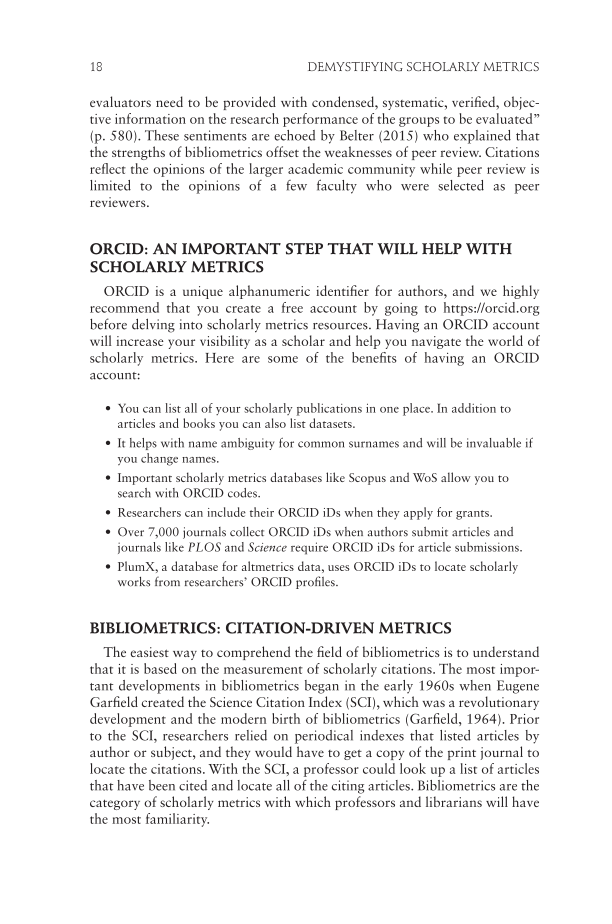18 DEMYSTIFYING SCHOLARLY METRICS evaluators need to be provided with condensed, systematic, verified, objec- tive information on the research performance of the groups to be evaluated” (p. 580). These sentiments are echoed by Belter (2015) who explained that the strengths of bibliometrics offset the weaknesses of peer review. Citations reflect the opinions of the larger academic community while peer review is limited to the opinions of a few faculty who were selected as peer reviewers. ORCID: AN IMPORTANT STEP THAT WILL HELP WITH SCHOLARLY METRICS ORCID is a unique alphanumeric identifier for authors, and we highly recommend that you create a free account by going to https://orcid.org before delving into scholarly metrics resources. Having an ORCID account will increase your visibility as a scholar and help you navigate the world of scholarly metrics. Here are some of the benefits of having an ORCID account: • You can list all of your scholarly publications in one place. In addition to articles and books you can also list datasets. • It helps with name ambiguity for common surnames and will be invaluable if you change names. • Important scholarly metrics databases like Scopus and WoS allow you to search with ORCID codes. • Researchers can include their ORCID iDs when they apply for grants. • Over 7,000 journals collect ORCID iDs when authors submit articles and journals like PLOS and Science require ORCID iDs for article submissions. • PlumX, a database for altmetrics data, uses ORCID iDs to locate scholarly works from researchers’ ORCID profiles. BIBLIOMETRICS: CITATION-DRIVEN METRICS The easiest way to comprehend the field of bibliometrics is to understand that it is based on the measurement of scholarly citations. The most impor- tant developments in bibliometrics began in the early 1960s when Eugene Garfield created the Science Citation Index (SCI), which was a revolutionary development and the modern birth of bibliometrics (Garfield, 1964). Prior to the SCI, researchers relied on periodical indexes that listed articles by author or subject, and they would have to get a copy of the print journal to locate the citations. With the SCI, a professor could look up a list of articles that have been cited and locate all of the citing articles. Bibliometrics are the category of scholarly metrics with which professors and librarians will have the most familiarity.
Document Details My Account Print multiple pages
Print
You have printed 0 times in the last 24 hours.
Your print count will reset on at .
You may print 0 more time(s) before then.
You may print a maximum of 0 pages at a time.





































































































































































































































